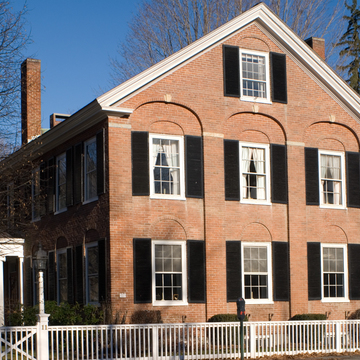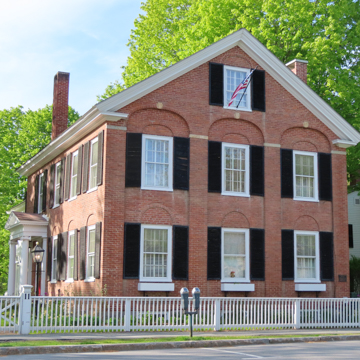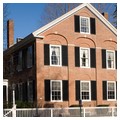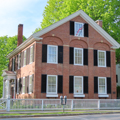This Federal house exploits the traditions of Windsor County arcaded brickwork to produce a design of noteworthy sophistication. The house's gable front faces the green. It seems likely that an original front side-hall entrance in the left-hand bay of the facade was superseded by the one under the Greek Revival Ionic porch on its side and replaced by a window. Regardless of the location of the entrance, it is the facade toward the green that dominates this building. Here the builder has taken the contemporary Woodstock motif of recessed arches over individual doors and windows and used it to create a wall that works with great logic in three planes. The front plane is that of piers with marble imposts that carry the cornice returns of the gabled roof and a series of three broad elliptical keystoned arches. They frame two-story recessed panels with windows set beneath their own recessed arched tympana, which are semicircular on the first floor and elliptical above. Fine proportions and concentric relationships lock the various facade components into a carefully integrated system with simultaneous implications of arcade and temple front. The relieving arch has matured into a local design motif, used in numerous buildings in the Woodstock area with wall piers and recessed panels. In this house it resulted in a complexity and refinement with reverberations of Charles Bulfinch, Peter Banner, Alexander Parris, and Benjamin Latrobe.
You are here
House
If SAH Archipedia has been useful to you, please consider supporting it.
SAH Archipedia tells the story of the United States through its buildings, landscapes, and cities. This freely available resource empowers the public with authoritative knowledge that deepens their understanding and appreciation of the built environment. But the Society of Architectural Historians, which created SAH Archipedia with University of Virginia Press, needs your support to maintain the high-caliber research, writing, photography, cartography, editing, design, and programming that make SAH Archipedia a trusted online resource available to all who value the history of place, heritage tourism, and learning.


















